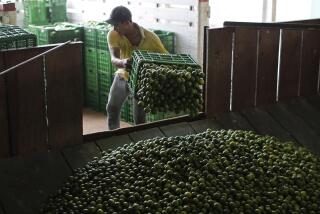Low Prices Burning N.M. Chile Farmers
- Share via
HATCH, N.M. — The mayor of this southern New Mexico town won’t eat a plate of eggs unless they’re smothered with chiles.
“I get my chile bottle out and I have a little for breakfast, lunch and supper,” Gilbert Bartlett says. “I love that hot chile and can eat it as hot as anybody.”
Bartlett lives in the heart of the Hatch Valley--the largest chile-producing area in the nation. The valley is littered with rows and rows of what has become over the last century the state’s most valuable vegetable crop.
Farmers this season are harvesting what they call one of the best crops in years. However, they are grappling with an uncertain future as market prices for chiles, onions and other commodities spiral downward under pressure from rising imports.
And, in a state that so loves its chiles it has become the de facto state symbol--the hot peppers adorn everything from road signs and T-shirts to dish sets and jewelry--many farmers have cut back on the acres they grow. Some are even considering getting out of the business.
“Chile really transcends being just a crop in New Mexico,” said Paul Bosland, director of the Chile Pepper Institute at New Mexico State University. “It’s really part of culture, part of our essence, part of our experiences.”
Bill Gomez, an economist with the university’s Cooperative Extension Service, said a consistent increase of imports has left many New Mexico farmers with overstocked warehouses and no growing contracts.
New Mexico’s raw chile crop has brought in an average of $55 million a year for the last 10 years. When counting their processing--turning them into everything from salsa and canned jalapeno slices to food coloring--the industry is worth some $250 million a year to the state.
About 80 percent of the crop is grown for processing, while the other 20 percent is for the fresh market.
Competition heated up in the mid-1990s, when imports from Mexico skyrocketed from 5,700 tons to 48,500 tons a year.
Taste of Local Products Touted as Strong Suit
Many farmers blame the North American Free Trade Agreement for the increase in imports. NAFTA, which took effect in 1994, was designed to eventually do away with tariffs on imports.
“Mexico has been coming in with that cheap chile and we can’t compete,” said Alex Franzoy, an 89-year-old farmer whose father was the first grower in the Hatch Valley to raise chiles for market.
Franzoy’s father planted about 10 acres of chiles north of Hatch and sold his peppers for 10 cents a pound. Franzoy was accustomed to getting up to $2 a pound for his best chiles, but these days he’s working hard to make $1.30.
“We can’t afford to grow it for that price,” he said.
Bartlett, the chile-loving mayor, believes New Mexico’s peppers will remain a force in the market despite the low price of chiles coming from outside the country. He said the reason is taste.
“There’s just something about the soil here that it just turns out with a better flavor,” he said.
Bosland said the state’s intense sunlight and cool nights give the peppers a taste that is different from varieties grown elsewhere.
Farmers, who began harvesting their crops in August, are thanking a gentle growing season for keeping pests and plant viruses at bay.
Last year they lost millions of dollars as bad weather and a wave of diseases battered the chile plants. Thousands of acres were left wilted and fruitless.
Nearly 400 farmers throughout the state raise chiles. Many have done so for decades.
Dickie Ogaz, a pepper farmer for nearly 40 years, now tends about 120 acres. He said he grew up helping his father with the farm and his sons followed in his footsteps until they went to college. Ogaz’s youngest son decided to stick with farming and his other two became engineers.
Ogaz and other farmers say the family affair could soon become a thing of the past.
“It’s already happening here in our community and everywhere else. There’s no money in it,” he said. “When I started farming, you could make a good living with a little bit of land. But now you can’t; everything is so expensive.”
According to statistics from the New Mexico Department of Agriculture, just over 16,000 acres were harvested in 1999, down 25 percent from a year earlier. At the peak of cultivation in 1992, nearly 35,000 acres were devoted to chiles.
Risks of Farming Cause Many to Flee the Ranks
Chris Franzoy, another member of the 500-member Franzoy family, is also aware of the inherent gamble of farming.
“People tell me that the stock market is a gamble,” he said. “But if you ask a farmer in his opinion what is more risky--investing $100,000 into his farming operation or investing $100,000 in the stock market--he would tell you he’d rather invest it in the stock market.”
Franzoy said he was born into chile farming, but he believes his children will likely have a different livelihood.
“I will definitely discourage them against farming because everything is against us,” he said as he looked across hundreds of rows of 2-foot chile stands.
Bartlett said that during his 53 years in the Hatch Valley, he has watched the farming community dwindle. Now, he said, only a dozen families farm the valley.
“People can’t figure out why businesses have had to close up in Hatch over the years,” he said. “That’s not hard for me to figure out when you got 40 or 50 farmers in the valley making a living and then a dozen farmers take over the land.
“It’s getting hard for these little towns.”
More to Read
Sign up for Essential California
The most important California stories and recommendations in your inbox every morning.
You may occasionally receive promotional content from the Los Angeles Times.










